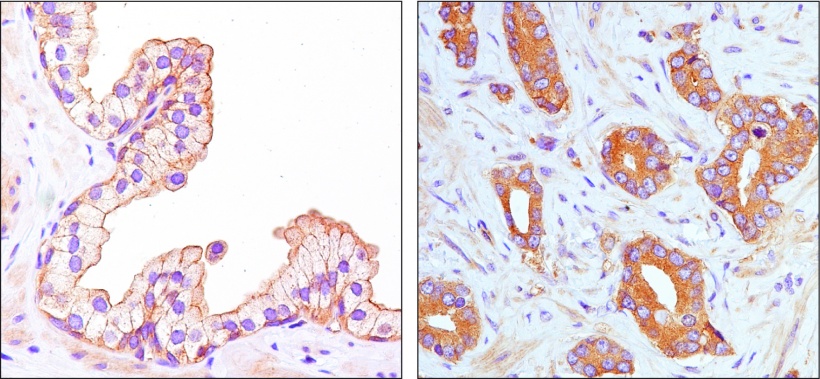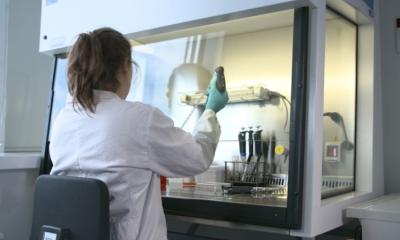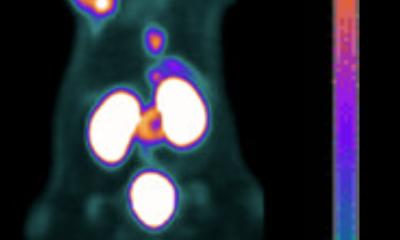News • Metastasis
Prostate cancer cells become ‘shapeshifters’ to spread to distant organs
Johns Hopkins Kimmel Cancer Center scientists report they have discovered a biochemical process that gives prostate cancer cells the almost unnatural ability to change their shape, squeeze into other organs and take root in other parts of the body.
For the study, the Johns Hopkins scientists mined publically available research data on the genetics and chemistry of hundreds of primary and metastatic cancers included in five studies of men with prostate cancer. They found that a gene called AIM1 (aka “absent in melanoma 1”), which makes proteins also called AIM1, is deleted in approximately 20 - 30 percent of prostate cancers confined to the gland and about 40 percent of metastatic prostate cancers. In addition, the scientists found, on average, two- to fourfold less amounts of AIM1 expression in metastatic prostate cancers compared with normal prostate cells or those from men with prostate cancers confined to the prostate, suggesting that reduction of AIM1 proteins is somehow linked to tumor spread.
Aside from its link to the development of melanoma, a deadly skin cancer, scientists knew little about the function of AIM1. “Our experiments show that loss of AIM1 proteins gives prostate cancer cells the ability to change shape, migrate and invade. These abilities could allow prostate cancer cells to spread to different tissues in an animal and presumably a person,” says Michael Haffner, M.D., Ph.D., a pathology resident and former postdoctoral fellow at the Johns Hopkins Kimmel Cancer Center who is involved in the research. “It’s not the whole story of what is going on in the spread of prostate cancer, but it appears to be a significant part of it in some cases.”

Looking more closely at the AIM1 gene and its protein levels in prostate cancer tissues, the Johns Hopkins scientists found that many times, even when the gene isn’t completely deleted and its protein production is reduced, its location in the prostate cancer cell is highly abnormal compared with normal prostate cells. This occurs even in primary prostate cancer cells, which have invaded the local structures to form invasive cancer within the prostate gland, say the scientists.
The research team used dyes to track the location of AIM1 proteins in human cells grown in the lab and followed where they appear in normal and cancerous prostate tissues. In normal prostate cells, AIM1 was located along the outside border of each cell and paired up with a protein called beta-actin that helps form the cell’s cytoskeleton, or scaffolding. However, in prostate cancer cells, the protein spread away from the outer border of the cells and no longer paired up with beta-actin. The scientists found this pattern among a set of human prostate tissue samples including 81 normal prostates, 87 localized prostate cancers and 52 prostate cancers that had spread to the lymph nodes. “It appears that when AIM1 protein levels drop, or when it’s abnormally spread throughout the cell instead of confined to the outer border, the prostate cancer cells’ scaffolding becomes more malleable and capable of invading other tissues,” says Vasan Yegnasubramanian, M.D., Ph.D., associate professor at the Kimmel Cancer Center and a member of the research team. With AIM1, the scaffold, Yegnasubramanian says, keeps normal cells in a rigid, orderly structure. Without AIM1, cells become more malleable, shapeshifting nomads that can migrate to other parts of the body, he says.
AIM1 may help prostate cancer cells disseminate throughout the body, but something else may be helping them form full-blown metastatic tumors when they get there
Vasan Yegnasubramanian
To track how these shapeshifting cancer cells move, the Johns Hopkins scientists, with Steven An, Ph.D., an expert in cellular mechanics and an associate professor at the Johns Hopkins Bloomberg School of Public Health, took a close-up look at AIM1-lacking prostate cancer cells, using sophisticated and quantitative single-cell analyses designed to probe the material and physical properties of the living cell and its cytoskeleton. They found that cells lacking AIM1 remodeled their scaffolding more than twice as much as cells that had normal levels of AIM1, and that they exert three- to fourfold more force on their surroundings than cells with normal levels of the protein. Such cellular properties are reminiscent of cells with high potential to invade and migrate, An notes.
In addition, the scientists found that AIM1-lacking prostate cells were capable of migrating to unoccupied spaces on a culture dish or invading through connective tissue-like materials at rates fourfold higher than cells with normal levels of AIM1. Next, the scientific team implanted human prostate cancer cells engineered without AIM1 in five mice and found that the cells spread to other tissues at levels 10 to 100 times more than cells with normal levels of AIM1 that were implanted in five similar mice. However, the AIM1-lacking cells were not able to establish full colonies and tumors at those other tissues, suggesting that AIM1 depletion is not the whole story in the spread and growth of metastatic prostate cancer. “AIM1 may help prostate cancer cells disseminate throughout the body, but something else may be helping them form full-blown metastatic tumors when they get there,” says Yegnasubramanian.
The Johns Hopkins scientists plan to further study what happens to the AIM1 protein to cause its abnormal location in prostate cancers and identify other proteins and genes that work with AIM1 to cause metastasis. Such studies could help scientists find new drug targets aimed at preventing or reversing prostate metastasis.
Source: Johns Hopkins Medicine
09.08.2017











